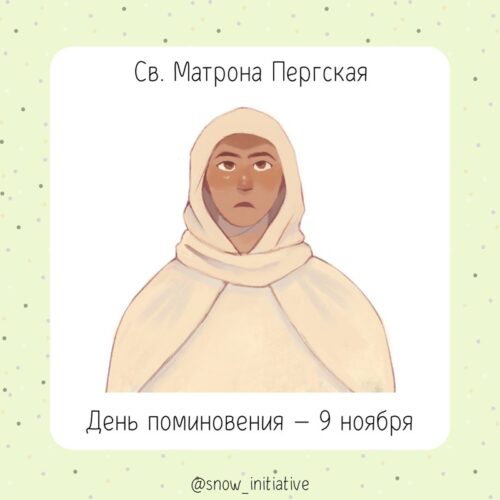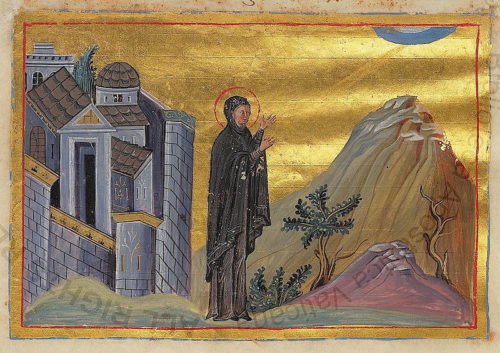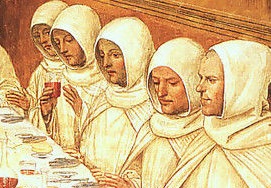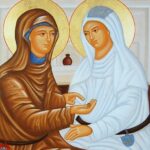Last Updated on November 9, 2024 by Kittredge Cherry

Saint Matrona of Perge, who lived as a eunuch named Babylas, founded a convent where nuns dressed as men in 5th-century Constantinople. The feast day of Matrona / Babylas is Nov. 9.
Nuns under the leadership of Matrona / Babylas were granted a unique privilege by the local abbott: “He did not give her woolen girdles and veils such as women were accustomed to wear, but men’s wide black leather belts and men’s white mantles. And these they wore continuously,” says an early source quoted in “Passionate Holiness: Marginalized Christian Devotions for Distinctive People” by Dennis O’Neill. The book covers many queer saints and has a whole chapter on “Saint Matrona of Perge and Her Other Nuns Who Dressed as Men.”
The story of Matrona / Babylas is similar to more than a dozen queer saints who are venerated as women who cross-dressed in order to serve God and avoid marriage. An overview of them is presented in “Trans Saints? Early cross-dressing monks and martyrs.”
Q Spirit is pleased to share the following profile of Matrona / Babylas by Terence Weldon, a gay Catholic expert on queer saints. Language for describing transgender experience is changing quickly. This article maintains all of Weldon’s original wording, even though some vocabulary may already seem outdated.
Nov 9th: St. Matrona/Babylas of Perge
By Terence Weldon
(Reposted from Queering the Church with permission)
St Matrona /Babylas of Perge is one of a number of female saints in the early church who dressed as men to be admitted to all-male monasteries. The stories and motives of these women are remote from our time, and ‘transvestite’ is not to be confused with ‘transgendered’. Still, whatever the full historic truth, it seems to me these are useful stories to hold on to as reminders of the important place of the transgendered, and differently gendered, in our midst. Many of us will remember how difficult and challenging was the process of recognising, and then confronting, our identities as lesbian or gay, particularly in the context of a hostile church.

Matrona of Perge from the Menologion of Basil II, an 11th-century illuminated Byzantine manuscript with 430 miniatures, now in Vatican library (Wikipedia)
However difficult and challenging we may have found the process of honestly confronting our sexual identities, consider how much more challenging must be the process of confronting and negotiating honestly a full gender identity crisis. Their stories collectively also carry a sobering reminder of the differing regard given by society of the time to male and female lives – else why would women have sought out male monasteries, in spite of the risks and discomfort to themselves of their lives in disguise, if not expectation of some greater spiritual reward than in a female convent?
Our Holy Mother Matrona (492 AD):
She was from Perga in Pamphylia, and married very young, to a youth named Domitian, to whom she bore a daughter. The couple settled in Constantinople. Matrona became so constant in attending all-night vigils in the city’s many churches that her husband suspected her of infidelity and forbade her to go out. This was unbearable to Matrona, who fled the house with her daughter. Determined to embrace monastic life, she gave her daughter into the care of a nun named Susanna, disguised herself as a eunuch, and entered the monastery of St Bassian (October 10) under the name of Babylas. Though she amazed all with her zeal and ascetic labors, Bassian one day discerned that she was a woman. Though he reprimanded her severely because of her zeal, he was unwilling to drive her away from monastic life because of her zeal; so he directed her to go to Emesa in Syria to enter a certain women’s monastery there.
Matrona continued to advance in the virtues, and once healed a blind man by anointing his eyes with myrrh from the head of St John the Baptist (which had been miraculously discovered around that time). The miracle became widely-known, and because of it Matrona’s husband learned of her whereabouts. When he came to her monastery she escaped to Jerusalem, but he pursued her there too. She fled from place to place, even living for several years in an abandoned pagan temple in Beirut, where she was constantly assaulted by the demons that inhabited the place. In time several pagan women, seeing her struggles, asked to be her disciples, and a small monastic community sprang up in the pagan temple. After a few years she and her disciples made their way back to Constantinople, where St Bassian received her joyfully and helped her to establish a monastery. There she was visited by the Empress Verina, wife of Leo the Great, and many other noblewomen of the City, some of whom left all to join Matrona in monastic life. Saint Matrona lived to be almost one hundred years old and reposed in peace, having foretold the day of her death.
–“God is Wonderful in His Saints“
(For much more on the history of Matrona / Babylas, see the “The Life of St. Matrona of Perge, as given by Symeon Metaphrates”, (available on-line at the Medieval Sourcebook).
___

Terence Weldon is an openly gay Catholic who blogged at Queering the Church. Originally from South Africa, he is a partnered father and grandfather based in the United Kingdom.
___

Is this what the cross-dressing nuns looked like? Detail from a painting by Il Sodoma (WikiGallery)
Editor’s note: I searched hard a painting of Matrona / Babylas with the nuns dressed as men, but couldn’t find any. This image of androgynous monks may give some sense of their style. It is painted by the Renaissance artist known as “Il Sodoma,” a reference to his reputation for homosexuality.
Books and links related to Matrona / Babylas of Perge
Reading Matrona: The Sixth Century Life of a Trans Saint (doctoral dissertation by Rebecca E. Wiegel)
“Passionate Holiness: Marginalized Christian Devotions for Distinctive People” by Dennis O’Neill
“Holy Women of Byzantium: Ten Saints’ Lives in English Translation” by Alice-Mary Talbot
“Women of Bible Lands: A Pilgrimage to Compassion and Wisdom” by Martha Ann Kirk
 Medieval society was fascinated by female-to-male cross-dressing. “Clothes Make the Man: Female Cross Dressing in Medieval Europe” by Valerie R. Hotchkiss has a wonderful “Hagiographic Appendix” with short bios of no less than 34 “transvestite saints.” All of them involve some form of cross-dressing to serve God, protect their virginity or avoid marriage.
Medieval society was fascinated by female-to-male cross-dressing. “Clothes Make the Man: Female Cross Dressing in Medieval Europe” by Valerie R. Hotchkiss has a wonderful “Hagiographic Appendix” with short bios of no less than 34 “transvestite saints.” All of them involve some form of cross-dressing to serve God, protect their virginity or avoid marriage.
___
Top image credit:
“St. Matrona of Perge: Day of Remembrance – Nov 9” by Snow Initiative (Инициатива СНеГ), a group by and for nonbinary people, based in St. Petersburg, Russia.
https://www.instagram.com/snow_initiative/
___
This post is part of the LGBTQ Saints series by Kittredge Cherry. Traditional and alternative saints, people in the Bible, LGBT and queer martyrs, authors, theologians, religious leaders, artists, deities and other figures of special interest to lesbian, gay, bisexual and transgender and queer (LGBTQ) people and our allies are covered.
This article was originally published on Q Spirit in November 2019, was expanded with new material over time, and was most recently updated on Nov. 9, 2024.



















Even the quoted passage from Terence Weldon admits : “The stories and motives of these women are remote from our time, and ‘transvestite’ is not to be confused with ‘transgendered’.” In this case their motive is pretty clear and was approved even by the local abbot, hence we’re not dealing with a transgender issue here. Calling them “queer” as a convenient catch-all term is a classic case of using overly broad terminology to justify categorization that cannot be justified in any other manner.
I am delighted with with the familiar conferes et soeurs that inhabit these pages. Dennis and I are from the same archdiocese. I don’t exactly what he is doing now, but we use his icon of Sts S and B in our website and for my golden jubilee worship folder. I think he was the spiritual director for AGLO when I was still in Chicago.
Matrona is a relatively common female name in the Slavic Community. So I have run into the name before, but not so much wissenschaft which I dearly love